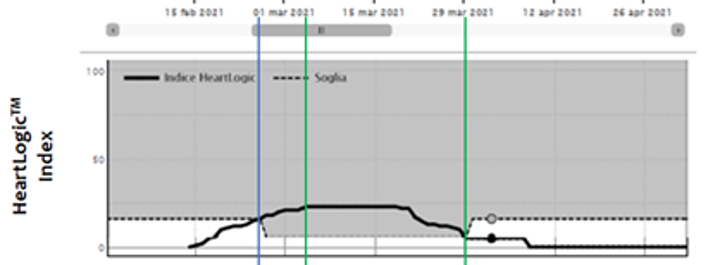In this new issue of the newsletter, we describe in detail the last findings on the performances of HeartLogic in clinical practice from the RE-HEART registry.
In this issue you can also find a new case of the month.
RE-HEART Spanish Registry
Recently a paper from Spanish HeartLogic Registry has been published by Dr. De Juan Baguda on the Revista Española de Cardiología†.
Tratamiento a distancia de la insuficiencia cardiaca mediante el algoritmo HeartLogic. Registro RE-HEART
(Remote heart failure management using the HeartLogic algorithm. RE-HEART Registry.)
At the time of newsletter content creation, the paper is available only in Spanish language on the Journal website, but within few weeks the English version should be released and indexed in Pubmed.
Some of the results from this study have been previously presented at ESC 2021 and ESC-HF 2021 Congresses and extensively reported in previous Newsletters #7 and #8.
In brief, the study was an independent Registry that, for this first analysis, involved 15 HeartLogic centers in Spain and included a total of 288 patients who had received a Boston Scientific ICD or CRT-D device equipped with HeartLogic.
The design of the study included three different phases:
- Blinded phase: analysis of correlation between clinical events occurred and HeartLogic value in a period when physicians were blinded to the HeartLogic index.
- Prospective phase in clinical practice: HF patient management using HeartLogic per local practice
- Prospective phase in clinical practice: HF patient management using HeartLogic following a standardized protocol
Blinded Phase (Phase 1): 101 patients in analysis
During a median observation period of 10 [95% CI: 5 – 19] months the HeartLogic index crossed the threshold value 73 times in 39 patients > 0.72 alerts/patient-year
During HeartLogic in alert state:
- 8 HF hospitalizations and 2 emergency room admissions occurred in 9 patients > 0.10 events/patient-year
- 10 minor events (HF in-office visits and non-HF hospitalization)
No HF hospitalizations were associated with HeartLogic OUT of alert state and the unexplained alert rate was 0.52 alerts/patient-year.
Active Phases (Phase 2 and 3): 267 patients in analysis.
During a median observation period of 16 [95% CI: 15 – 22] months, the HeartLogic index crossed the threshold value 277 times in 136 patients > 0.89 alerts/patient-year. The alerts were classified as following:
- 120 alerts unexplained (0.39 alert/pt-year)
- 78 alerts non-HF related (0.25 alerts/pt-year)
- 79 alerts HF related (0.25 alerts/pt-year)
- 27 associated with hospitalizations for HF 6 associated with HF death
- 46 associated with HF unplanned in-office visit
During the active phases, one HF hospitalization and one unplanned in-office visit for HF occurred when patients were in OUT of alert state
Phase 2 Vs Phase 3: Alert Management
94 patients were included in the Phase 2 and 267 patients in the Phase 3.
In the Table 1 you can find the main information about the alert management strategies in phase 2 and phase 3:
| Phase 2 (FU 7 Months) | Phase 3 (FU 13 Months) | p |
Number of Alerts (alert/pt-yr) | 44 (0.81) | 233 (0.91) | 0.509 |
Remote Alert Management, n (%) | 36 (82) | 188 (81) | 0.861 |
Phone contacts (contacts/pt-yr) | 0.65 | 1.12 | 0.002 |
Actionable Alerts, n (%) | 12 (27) | 91 (39) | 0.138 |
HeartLogic alerts and NT-proBNP:
194 NT-proBNP measures were taken, and 32 were associated with an HF event.
The median NT-proBNP values were (Figure 1):
- 8624 [25th-75th percentile: 2592-19503] pg/ml at the time of HF events
- 1213 [25th-75th percentile: 597-2350] pg/ml (p<0.001) at non-HF events.
39 NT-proBNP measures were taken when the HeartLogic index was IN alert state.
The median NT-proBNP values were:
- 7378 [25th-75th percentile: 2214-19377] pg/ml IN alert state
- 1210 [25th-75th percentile: 599-2276] pg/ml (p<0.001) OUT of alert state.
HeartLogic Performance:
The performance of HeartLogic during Blinded and Active phases are reported in the table 2 and compared with previous validation and real world studies.
| MultiSENSE¹ (validation dataset) | Capucci et al² | Santini et al.³ | Treskes et al.⁴ (ESC-HF 20921) | Feijen et al.⁵ (ESC-HF Cong 2021) | RE-HEART Blinded Phase (Rev Esp Card 2021) | RE-HEART Unblinded Phases (Rev Esp Card 2021) |
Patients | 400 | 58 | 104 | 68 | 82 | 101 | 267 |
Follow-up | 12 months | 5 months | 13 months (median) | 12 months | 14 months | 10 months | 16 months (median) |
Sensitivity | 70% | 100% | 69% | 90% | 93% | 100% | 98% |
Specificity | 87.5% | N/A | N/A | 89% | 97% | 93% | 90% |
Positive Predictive Value | 11% | 58% | 60% | 73% | 81% | 27% | 57% |
Unexplained Alert Rate | 1.47/pt-yr | 0.41/pt-yr | 0.37/pt-yr | 0.16/pt-yr | 0.24/pt-yr | 0.52/pt-yr | 0.39/pt-yr |
Time in alert (of observation period) | 17% | 12% | 15% | N/A | N/A | 8% | 11% |
Conclusions:
- This experience from a large number of Spanish centers demonstrated a good correlation between HeartLogic alerts and HF decompensation events, with a low rate of unexplained alerts.
- The vast majority of alerts could be remotely managed and solved by telephone with a low workload for the centers: the most frequent action was the adjustment of diuretic treatment.
- The data support that decompensation of HF is highly unlikely outside of the alert period.
- The analysis of biomarkers demonstrates that NT-proBNP concentrations are significantly elevated when HearLogic is IN alert status.
- This additional real-world experience confirms the high performance of HeartLogic previously demonstrated in validation studies.
Case of the month
A 56-year old man with family history of coronary artery disease, NYHA Class II, hypertension and mixed dyslipidemia, underwent in October 2020 a PCI for anterior STEMI.
In December the patient was hospitalized for heart failure…

















